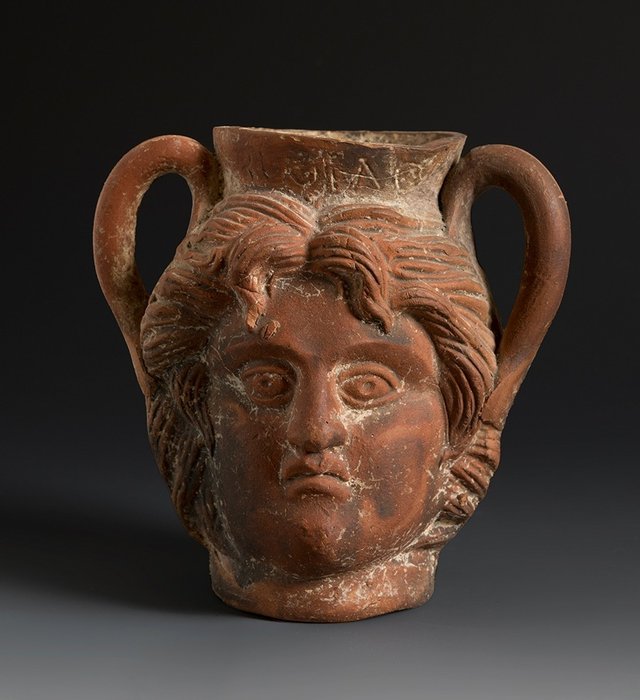
Romain antique Marbre Héraclès Epitrapèzes avec la peau de Lion de Némée. 57 cm H. Qualité et Important.
Nº 80385925

Nº 80385925

FIGURATIVE VASE WITH GREEK INSCRIPTION
Ancient Rome · 2nd century AD
Terracotta
Height 10 cm
Provenance
- Private collection, Columbus (USA), formed between 1970 - 1980. Purchased on the American art market.
Condition
Good condition, no restorations.
Roman plastic terracotta vase in the shape of a male head in rounded bulk. It is made by modeling and not using a mold, as evidenced by the fineness of the details and the high relief of the head.
From both sides of the head emerge the two vertical handles, of circular section, which seem to be born directly from the young man's hair. Curving, the handles end on both sides of a straight neck with a flat mouth, which has an incised inscription in Greek on the front. The letters, lowercase, are very lost due to the passage of time, but some can be distinguished: βω[φ]λ(...). The use of Greek in Roman inscriptions was very common, since it was the common language for the entire eastern half of the empire. Although most of the Roman inscriptions have been preserved on stelae, coins and insets, there is also an important corpus of inscribed vases with texts of various types, mainly made in glass but also in terracotta (fig. 1).
The face of the personage represented follows Greek models: wide and rounded jaw, straight triangular nose and small, closed mouth with full lips. The eyes, large and with thick eyelids, with prominent pupils worked in hollow, show an almost hallucinatory expression, staring straight ahead. The hair takes on great prominence in the representation; modeled strand by strand, it forms two symmetrical curls on the forehead and is arranged in wide waves on both sides of the face. At the back, on the other hand, it has less volume and is worked with shallower incisions. The head is placed on a clearly differentiated foot, which also functions as a neck.
Numerous plastic vessels (with the sculptural design deposit) can already be found in Greek art, and it was also a widely developed typology in Rome (fig. 2). Originally, they were mainly pieces for ritual or votive use, sometimes even without an interior cavity. However, with the development of the technique of glass blowing, and more specifically the mold blowing, this type of pieces, already in use, will come to enjoy a great development throughout the empire (fig. 3).
Bibliography
- HAYES, J.W. Handbook of Mediterranean Roman Pottery. University of Oklahoma Press. 1997.
- LIGHTFOOT, C. “Roman Inscriptions.” In Heilbrunn Timeline of Art History. New York: The Metropolitan Museum of Art, 2000–. Http://www.metmuseum.org/toah/hd/insc/hd_insc.htm (febrero de 2023).
Parallels
Fig. 1 Vase fragment inscribed with stamp of its author: SEX∙AVLIENI (from Sextus Aulenius). Roman Empire, ca. 10 BC. - 20 A.D., terra-cotta. Metropolitan Museum, New York, inv. 17.194.1930.
Fig. 2 Oinochoe with satyr's head. Roman Empire, 2nd century A.D., terra-cotta. Musée du Louvre, Paris, inv. H 142; Cp 3649.
Fig. 3 Vase in the form of a male head. Roman Empire, second half of the 1st century AD, glass. Metropolitan Museum, New York, inv. 29.100.75.
Notes:
- The piece includes authenticity certificate.
- The piece includes Spanish Export License.
- The seller guarantees that he acquired this piece according to all national and international laws related to the ownership of cultural property. Provenance statement seen by Catawiki.
#theaterasia
Comment acheter sur Catawiki ?
1. Découvrez des objets d’exception
2. Faites la meilleure offre
3. Effectuez un paiement sécurisé